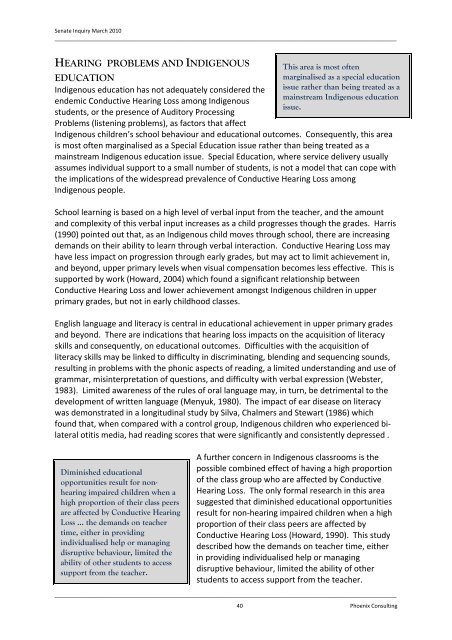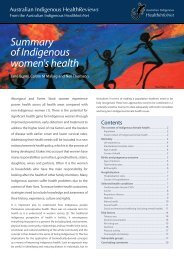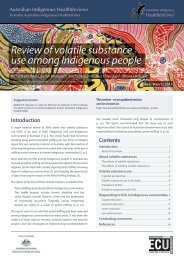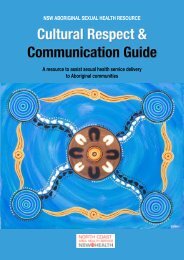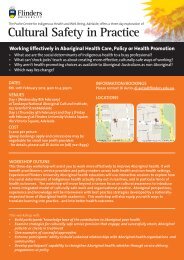hearing loss and the criminal justice system - Australian Indigenous ...
hearing loss and the criminal justice system - Australian Indigenous ...
hearing loss and the criminal justice system - Australian Indigenous ...
Create successful ePaper yourself
Turn your PDF publications into a flip-book with our unique Google optimized e-Paper software.
Senate Inquiry March 2010_________________________________________________________________________________________________________________HEARING PROBLEMS AND INDIGENOUSEDUCATION<strong>Indigenous</strong> education has not adequately considered <strong>the</strong>endemic Conductive Hearing Loss among <strong>Indigenous</strong>students, or <strong>the</strong> presence of Auditory ProcessingProblems (listening problems), as factors that affectThis area is most oftenmarginalised as a special educationissue ra<strong>the</strong>r than being treated as amainstream <strong>Indigenous</strong> educationissue.<strong>Indigenous</strong> children’s school behaviour <strong>and</strong> educational outcomes. Consequently, this areais most often marginalised as a Special Education issue ra<strong>the</strong>r than being treated as amainstream <strong>Indigenous</strong> education issue. Special Education, where service delivery usuallyassumes individual support to a small number of students, is not a model that can cope with<strong>the</strong> implications of <strong>the</strong> widespread prevalence of Conductive Hearing Loss among<strong>Indigenous</strong> people.School learning is based on a high level of verbal input from <strong>the</strong> teacher, <strong>and</strong> <strong>the</strong> amount<strong>and</strong> complexity of this verbal input increases as a child progresses though <strong>the</strong> grades. Harris(1990) pointed out that, as an <strong>Indigenous</strong> child moves through school, <strong>the</strong>re are increasingdem<strong>and</strong>s on <strong>the</strong>ir ability to learn through verbal interaction. Conductive Hearing Loss mayhave less impact on progression through early grades, but may act to limit achievement in,<strong>and</strong> beyond, upper primary levels when visual compensation becomes less effective. This issupported by work (Howard, 2004) which found a significant relationship betweenConductive Hearing Loss <strong>and</strong> lower achievement amongst <strong>Indigenous</strong> children in upperprimary grades, but not in early childhood classes.English language <strong>and</strong> literacy is central in educational achievement in upper primary grades<strong>and</strong> beyond. There are indications that <strong>hearing</strong> <strong>loss</strong> impacts on <strong>the</strong> acquisition of literacyskills <strong>and</strong> consequently, on educational outcomes. Difficulties with <strong>the</strong> acquisition ofliteracy skills may be linked to difficulty in discriminating, blending <strong>and</strong> sequencing sounds,resulting in problems with <strong>the</strong> phonic aspects of reading, a limited underst<strong>and</strong>ing <strong>and</strong> use ofgrammar, misinterpretation of questions, <strong>and</strong> difficulty with verbal expression (Webster,1983). Limited awareness of <strong>the</strong> rules of oral language may, in turn, be detrimental to <strong>the</strong>development of written language (Menyuk, 1980). The impact of ear disease on literacywas demonstrated in a longitudinal study by Silva, Chalmers <strong>and</strong> Stewart (1986) whichfound that, when compared with a control group, <strong>Indigenous</strong> children who experienced bilateralotitis media, had reading scores that were significantly <strong>and</strong> consistently depressed .Diminished educationalopportunities result for non<strong>hearing</strong>impaired children when ahigh proportion of <strong>the</strong>ir class peersare affected by Conductive HearingLoss ... <strong>the</strong> dem<strong>and</strong>s on teachertime, ei<strong>the</strong>r in providingindividualised help or managingdisruptive behaviour, limited <strong>the</strong>ability of o<strong>the</strong>r students to accesssupport from <strong>the</strong> teacher.A fur<strong>the</strong>r concern in <strong>Indigenous</strong> classrooms is <strong>the</strong>possible combined effect of having a high proportionof <strong>the</strong> class group who are affected by ConductiveHearing Loss. The only formal research in this areasuggested that diminished educational opportunitiesresult for non‐<strong>hearing</strong> impaired children when a highproportion of <strong>the</strong>ir class peers are affected byConductive Hearing Loss (Howard, 1990). This studydescribed how <strong>the</strong> dem<strong>and</strong>s on teacher time, ei<strong>the</strong>rin providing individualised help or managingdisruptive behaviour, limited <strong>the</strong> ability of o<strong>the</strong>rstudents to access support from <strong>the</strong> teacher._________________________________________________________________________________________________________________40 Phoenix Consulting


